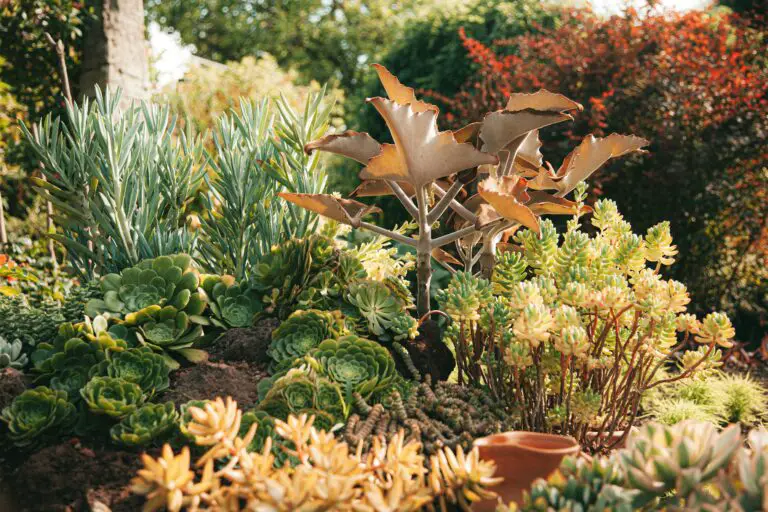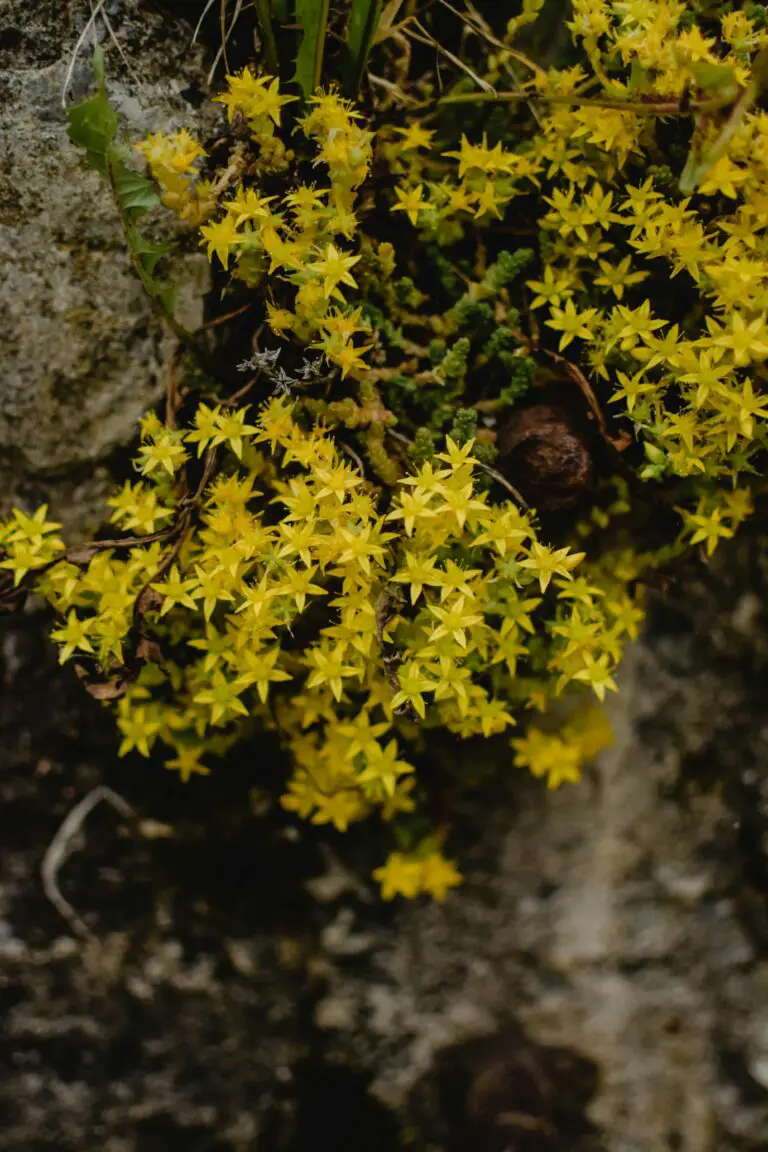Introduction to Sedum
When it comes to crafting a garden that’s as resilient as it is ravishing, sedum plants are a gardener’s best-kept secret. Known for their robust nature and striking beauty, sedums are the versatile virtuosos of garden design, weaving a tapestry of texture and color across your outdoor canvas.
Imagine a low-lying carpet of foliage buzzing with bees and butterflies, a spectacle of greenery unfurling in even the most inhospitable of terrains – that’s the magic of sedum. This hardy groundcover is not just about survival; it’s about conquest, spreading its tendrils across rocky soils and thriving where lesser plants would languish. Discover more about these resilient wonders and how to integrate them into your garden.
Whether it’s the roof gardens of urban spaces or the sprawling estates that dapple the countryside, sedum plants have exhibited an uncanny ability to adapt and spread. They are a testimony to nature’s ingeniosity – capable of covering ground with minimal fuss, demanding very little but giving back generously in the form of lush, verdant growth and vibrant blossoms.
Within the sedum family, there is a trove of varieties, each with its unique charm, ready to blanket different environments in shades of green, pink, and yellow. From the dappled shade of wooded areas to the unforgiving full sun of rocky outcroppings, sedums rise to the challenge, showcasing their capability to spread with grace and vigor.

The Spreading Nature of Sedum
Peering into the garden, one can’t help but notice the lush green tapestry that sedum plants weave across the landscape. These resilient succulents are adored by gardeners for their hardiness and simplistic beauty, but what’s truly fascinating is their ability to spread and cover ground. Sedum is not just a static beauty; it’s a dynamic groundcover that actively extends its reach, painting the garden with vibrant shades of green, pink, and burgundy.
Understanding how sedum spreads is akin to learning the secrets of an expert gardener. It’s a harmonious blend of botanical prowess and strategic care. Sedum plants, by their very nature, are designed to extend outward with stoloniferous vigour—sending out shoots and roots that, upon finding a hospitable patch of soil, establish new clusters of succulent life. This means that, given the right conditions, a single sedum plant can become the progenitor of an entire garden’s worth of vegetation.
The rate at which sedum spreads is influenced by a variety of factors, including sunlight, soil quality, and water availability. For more comprehensive insights, visit this detailed guide on sedum’s spreading rate. Plenty of sunlight and well-draining soil are typically sedum’s best friends, empowering these hardy plants to sprawl with ease. A particularly sunny summer can see sedum growth in leaps and bounds, crowding out weeds and gracing your garden with an almost instant carpet of texture and color.
For those looking to add a touch of sedum’s magic to their outdoor spaces, here’s a visual treat: check out this helpful . It offers a glimpse into growing sedum as a ground cover and hints at the spreading habit that makes these plants so desirable for gardeners seeking low-maintenance beauty.
Yet, as with all things in gardening, there’s a need for balance. Gardeners, beware: allowing sedum to spread unchecked can lead to overcrowding, which might stifle the growth of neighboring plants. This is where a bit of human intervention can play a pivotal role. Occasional propagation and pruning techniques will ensure that your sedum stays vibrant and healthy, forming a living mosaic that’s both controlled and wild at once.
Different Varieties of Sedum and Their Spread
Imagine a carpet of succulent green stretching across your garden, a vibrant patchwork that’s as hardy as it is beautiful. Welcome to the world of sedum, the go-to groundcover that’s a favorite among both novice gardeners and landscape aficionados. But did you know that not all sedum varieties are created equal when it comes to their ability to spread and cover ground? Let’s dive into the particulars of these fascinating plants and uncover what sets them apart.

On one hand, we have the creeping groundcovers, sedum species like the ever-popular Sedum spurium or “Dragon’s Blood,” known for its dragon-red leaves and tenacious nature. These types of sedum are akin to green glue, molding seamlessly to rockeries, spilling over walls, or hugging the curves of stepping stones. They multiply with a garden’s worth of ease, rooting at the nodes where stems make contact with the soil, creating an endearing patchwork over time.
In contrast, upright sedum varieties such as Sedum telephium proudly stand tall with their stout stems and clusters of star-shaped flowers. These notable characters are more individualistic in their spread, expanding through the garden in polite clumps rather than sprawling with abandon. Although not as rapidly covering terrain like their prostrate cousins, these sedums command attention with their structural beauty and serve as excellent focal points within the garden tapestry. Here’s how sedum stars in garden designs!
Using real-life examples, imagine the sedum-filled landscapes you may see at public gardens, where the groundcover varieties create an artist’s palette of color and texture. In your own backyard, a creeping sedum might connect the dots between other plantings, softening edges and providing a lush underfoot experience. Alternatively, as autumn approaches, upright sedums come into their own, with showy blooms that persist into the cooler months, offering both visual interest and a haven for pollinators.
From garden path warriors to stately border sentinels, sedum varieties have a spread and purpose for every garden’s needs. Assess your space, consider the character you wish to impart, and sedum will more than rise to the occasion. Just remember, these plants enjoy the sun and well-draining soil – give them that, and they’ll reward you tenfold with a verdant, ever-spreading garden glory.
Optimal Growing Conditions for Sedum Spread

Inviting sedum to flourish in your garden is like rolling out a green carpet of resilient beauty. But, to ensure that this hardy groundcover really takes off and establishes its verdant domain, the right growing conditions are paramount. Let’s dig into the soil, light, and water requirements that are the bedrock of sedum’s success.
Soil: The Foundation for Growth
The secret to sedum spread begins with the soil. These plants are not picky eaters; they thrive in well-drained, poor to average soil. They embody the survivalist spirit, making the most out of nutrient-spare environments where others might wither away. In fact, heavy, clay-rich or water-logged soils are the arch-nemesis of sedum, often leading to root rot—one obstacle you want to sidestep on the path to groundcover glory.
Light: Basking in the Sun’s Embrace
Sedum’s love affair with the sun is the stuff of gardening legends. They soak up full sun like enthusiastic sunbathers, spreading with vigor under its warming rays. You’ll notice, in sunny patches of the garden, sedum plants spread their wings—metaphorically speaking—to create an expansive tapestry of foliage and flowers. Partial shade may be tolerated by some varieties, but they’ll always lean towards the light, blossoming best when the sun’s kisses are plentiful.
Water: The Balancing Act of Hydration
Like a camel in a lush oasis, sedum doesn’t require frequent watering. Overindulgence in hydration can lead to a sedum’s downfall. Their succulent leaves store water, allowing them to withstand periods of drought with stoic resolve. This isn’t permission to overlook them during a heatwave, but a reminder to water with a thoughtful hand. If in doubt, let the soil dry out before watering again to cheer on the spread of your sedum without drowning its ambitions.
Embrace these guidelines and watch as your sedum transforms from humble plant to expansive ground-covering hero. For those eager to see their garden in full bloom, explore some practical sedum planting strategies. Be the artist of your own living mosaic as you guide the eager tendrils of sedum to create a masterpiece underfoot.
Propagation Techniques to Increase Sedum Spread
Looking to give your garden a lush, vibrant touch with a carpet of hardy sedum? Good news — this resilient groundcover is a snap to propagate! Let’s dive into the easy, yet satisfying world of sedum propagation, where anyone with a bit of curiosity can create a sea of green with just a few simple steps.

Starting Small: Propagation by Cuttings
Grab your garden shears and let’s get snipping! Fall in love with the simplicity of sedum’s ‘cut and plant’ method. All it takes is a healthy stem cutting, about 2-4 inches long. Snip it right below a leaf node, let it callous for a couple of days, then nestle it into a moist soil mix. Keep the faith and in just a few weeks, roots will reach out, securing a new home in your garden. Before you know it, these little champs will burgeon into robust sedum clusters. Remember, you can take cuttings throughout the growing season — just make sure the mother plant is healthy and happy!
Divide and Rule: Propagation by Division
No royal decree needed here — propagation by division is righteously simple. This method is ideal when your sedum has filled its space and begs for more territory. In spring or early fall, gently lift the plant, and with a clean, sharp knife, divide the rootball into sections, ensuring each has a piece of the crown and some roots. Replant these in chosen spots and watch as your garden bows to its new overlords.
The Seedy Side of Sedum: Propagation by Seeds
If you’re a patient gardener who enjoys the anticipation of growth, sedum seeds are your ticket to green-thumb excitement. Sprinkle seeds over a well-draining soil mix and press down lightly. Keep the soil consistently damp and in the embrace of indirect sunlight. Germination is a slow dance, taking anywhere from three weeks to a couple of months. But the wait is a small trade-off for the joy of watching these tiny green wonders emerge!
With these tips, you’re now armed to encourage your sedum to spread its wings (or should we say leaves?) in your garden. Whether you’re aiming for a rapid expansion or a controlled sprawl, propagation by cuttings, division, or seeds gives you the power to shape your verdant retreat. So, roll up those sleeves and get ready to be swept away by the infectious growth of sedum!
Landscaping with Sedum: Planning for Spread
Gardening enthusiasts often seek that perfect patch of green that requires minimum hassle but creates maximum impact. Enter Sedum, the hardy groundcover that beckons gardeners with its promise of an attractive, cohesive look without constant coddling. So, how can you leverage its spreading nature to beautify your greenspace? Let’s dig in.
Understanding Sedum’s Sprawl
Before you start drawing up plans for your future garden tapestry, it’s essential to recognize the different sedum varieties at your disposal. Some are polite neighbors, content with their parcel of land, while others have expansionist dreams, slowly inching into territories beyond. This creeping characteristic is not to be feared but embraced, for it carves an opportunity to form a dense, colorful mat that suppresses weeds and thrives with minimal water.
Designing with Dynamics
Imagine a natural quilt composed of succulent leaves, with varying shades of green, red, and gold. As will sedum spread becomes less of a question and more of a certainty, your design should account for growth patterns. Use spreading sedum around pavers, along pathways, or as a living mulch under taller plants. Its tenacity and tolerance for neglect make it an exemplary choice for slopes or rocky areas where other plants may falter.
Anecdotal evidence from seasoned gardeners recounts stories of sedum rescuing barren spots in the yard, where it’s not just about the spread but the revival of life. An alcove that once showcased barrenness can be transformed into a thriving ecosystem with sedum as the star.
Plant Partnership Perfection
When sedum joins forces with other garden dwellers, the results can be spectacular. Contrast its thick foliage with airy grasses or pair it with lavender for a medley of textures and scents. Considering sedum’s robust spreading habit allows for strategic interplanting, where sedum fills the gaps between seasonal bloomers, ensuring constant coverage.
Watch this informative video to get up close with the growth and care of Sedum hispanicum, also known as Spanish stonecrop, a popular spreader in gardens:
Remember, the key to a flourishing garden with sedum is anticipation. Anticipate the spread, factor it into your design, and watch as your garden transforms into a self-sustaining tapestry that’s the envy of any plant lover. By appreciating its spreading habit, you unlock a world of creativity and ease, making sedum not just a plant choice, but a smart gardening philosophy.
Managing and Controlling Sedum Overgrowth
As a groundcover, sedum can sometimes be a little too successful at making itself at home in your garden. So, what happens when this hardy invader starts eyeing up the rest of your flower beds with imperial ambition? That’s where savvy garden management comes into play.

First off, let’s talk about the nature of sedum. Known for its resilience and easy-care nature, this plant can spread with such gusto that before you know it, your garden is sporting more sedum than a green roof in downtown Sedumville. To keep this enthusiastic spreader in check, it’s essential to set some boundaries. Consider physical barriers like edging materials or underground dividers; these can be effective at reigning in its expansive tendencies.
Trimming Techniques: A Cut Above the Rest
Regular trimming can make a world of difference. A sharp pair of garden shears and a keen eye can transform an overzealous sedum patch into a well-behaved garden citizen. When you notice the runners sprinting towards other plant domains, a quick snip-snip can halt the invasion. It’s like having a friendly chat with your plants, letting them know who’s boss. After all, your garden is a democracy, not a vegetal dictatorship!
Creating Balance in the Garden Ecosystem
Creating a balance between sedum and other plants is akin to finding the perfect harmony in an ecosystem. Companion planting is a clever strategy here—select plants that offer a little friendly competition for resources without leading to garden warfare. Moreover, consider the spacing. Just like people need personal space, so do plants. Giving each one enough room to flourish ensures they all get along harmoniously.
Lastly, don’t underestimate the importance of regular garden maintenance. It’s not just about aesthetics; it’s about ecosystem health. Keeping an eye on your sedum’s spread is like monitoring a charming guest who’s becoming a long-term roommate. You want to ensure they’re contributing positively to the household and not eating all the snacks!
Incorporating these practices into your gardening routine can make the difference between a sedum that’s a joy and one that’s a bit of a bully. Remember, every garden is a canvas, and you’re the artist. With the right techniques up your sleeve, you can ensure that your tapestry of green is both beautiful and balanced.
Common Pests and Problems Affecting Sedum Spread
When it comes to the lush spread of sedum’s vibrant foliage, not all is smooth sailing in the garden. Like any good drama, there are antagonists waiting in the wings, ready to hinder our green carpet’s grand performance. We’re talking about the rogues’ gallery of pests and diseases that can make a meal out of sedum, interrupting its natural inclination to spread and thrive.
Meet the Usual Culprits: Pests on Patrol
Let’s introduce the usual suspects—fiendish pests like aphids, mealybugs, and spider mites. They’re like the pickpockets of the plant world, stealthily draining the life juices from sedum leaves, causing them to become discolored, wilted, and downright unsightly. Imagine a plant so drained of vigor that spreading out seems like a chore it simply can’t muster the energy for. That’s the nefarious work of these tiny critters.
When Diseases Join the Fray
But pests aren’t the only perpetrators; fungal diseases too can throw a wrench in the works. Sedum, resilient as it may be, can suffer from fungal foes like powdery mildew and root rot. These devious diseases cloak sedum’s leaves in a ghostly white or leave its roots to wallow in soggy despair. The result? A spread that’s as inhibited as a dancer with two left feet.
Real-life examples abound. Take Jane’s garden, where her once-lustrous dragon’s blood sedum started showing signs of powdery mildew. It was a misty, overcast season, the conditions just perfect for fungus to party. The spread of her groundcover slowed to a crawl until she took action with some organic antifungal goodness. Or consider Bob’s backyard, where overwatering his sedum collection led to root rot, transforming his would-be carpet into isolated islands of green in a sea of mulch.
Understanding the tug-of-war between sedum and its adversaries gives us insight into nurturing its spread. It’s more than just planting and admiring; it’s about vigilance, early detection, and timely intervention to ensure that sedum can perform its ground-hugging magic without a hiccup.
Armed with this knowledge and a watchful eye, you, too, can help your sedum thrive. For more tips on grappling with these green garden gremlins, let’s take a peek at a video that dives into the intricacies of managing common plant pests.
The Long-Term Benefits of Sedum in Your Garden
Imagine your garden transforming into a self-sustaining oasis of lush green, with minimal care from your side. This isn’t just a gardener’s daydream; it’s the real-life advantage of adding sedum to your landscape. When you introduce this hardy groundcover into your garden, you’re not only beautifying your outdoor space but also investing in a host of long-term ecological benefits.

Firstly, let’s talk about soil stabilization. Sedum’s tenacious root system grasps the earth firmly, preventing erosion and runoff, especially on slopes where rain can wash away precious topsoil. This steadfast grip on the ground ensures that your garden remains intact and the nutrient-rich soil stays put, aiding in the overall health of your garden ecosystem.
In an era where water conservation is more critical than ever, sedum stands out as a drought-resistant champion. These plants thrive in dry conditions, reducing the need for frequent watering. Sedum’s drought tolerance is exemplified in arid regions, where gardeners have witnessed them flourish while less hardy plants wilt and wither away. It’s a grass-roots solution to water-wise gardening that we all can embrace.
But perhaps the most buzzing topic in the ecological world is the plight of pollinators, and here, sedum offers a vital lifeline. Its star-shaped blooms are a magnet for bees, butterflies, and other beneficial insects, providing nectar and habitat when other sources are scarce. This isn’t just gardeners’ gossip; it’s proven that gardens rich with sedum act as biodiversity hotspots, offering a buffet for pollinators who play a crucial role in our food production and ecosystems.
By choosing sedum, you’re not just opting for an attractive groundcover; you’re engaging in a long-term ecological strategy that protects the earth, saves water, and supports wildlife. It’s a winning trifecta that captures the essence of sustainable gardening. As sedum spreads its verdant carpet across your garden, remember that each leaf is a testament to the resilient and bountiful nature of this remarkable plant.
Frequently Asked Questions
Are you wondering if your sedum will take over the garden or rather just cozy up contently in its designated spot? Well, you aren’t alone in pondering the spreading habits of this resilient groundcover. Let’s dig into some common questions gardeners have about sedum’s growth patterns and how to keep it in check.
How Fast Does Sedum Spread?
Like a gentle wave in a summer breeze, sedum spreads steadily but without haste. This plant doesn’t gallop across your garden; it’s more like a leisurely stroll. Depending on the variety, some sedums can expand their reach by a few inches a year, while others might leap an enthusiastic foot or more. Real-life examples? Picture the ‘Autumn Joy’ sedum, spreading its joy modestly, versus the ‘Dragon’s Blood’ that can leap with fiery zeal.
Will Sedum Take Over My Garden?
While sedum has the potential to spread, it’s not the garden bully you might envision. With minimal guidance, sedum can be a well-mannered guest in your outdoor space. If it starts to wander too far, a simple snip-snip here and there will remind it of its boundaries.
How Do I Encourage Sedum to Grow?
Pampering your sedum just right can coax it to fill in those bare patches you’ve been eyeing. Full sun, good drainage, and a watchful eye for over-watering are the keys to its heart. Like encouraging a shy child to make friends, giving sedum the right conditions and a little time will result in a blossoming spread of vibrant foliage.
What if Sedum is Growing Too Much?
If your sedum is having a bit too much fun and spreading where it shouldn’t, don’t fret. Sedum is resilient but responds well to firm, yet kind guidance. A simple division in spring or fall will tame its enthusiastic nature. Think of it like giving an energetic puppy a nice big yard to run in – it keeps them healthy and happy within a space you’re comfortable with.
Is your interest piqued? Imagine your garden paths lined with clusters of star-shaped blooms, a tapestry of greens, purples, and pinks lapping at the edges. Sedum isn’t just a plant; it’s a garden ally ready to cover the ground with colour and life, as long as you understand its spreading secrets.



